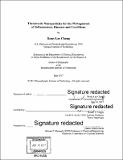Theranostic nanoparticles for the management of inflammatory diseases and conditions
Author(s)
Lee Chung, Bomy
DownloadFull printable version (22.65Mb)
Other Contributors
Massachusetts Institute of Technology. Department of Chemical Engineering.
Advisor
Robert S. Langer.
Terms of use
Metadata
Show full item recordAbstract
Atherosclerosis, the gradual buildup of plaques within arteries, is the main cause of cardiovascular diseases (CVDs). The World Health Organization reports that CVDs are the number one cause of death in the world. In the United States alone, around 85 million people suffer from CVDs; this is associated with a cost of over $316 billion per year and responsible for about a third of all deaths in the US. Recent findings have shown that inflammation plays a pivotal role in atherosclerosis. Although statins have traditionally been prescribed for their lipid-lowering benefits, studies have indicated that they can have other effects as well (so-called "pleiotropic effects"), including anti-inflammatory, anti-oxidant, and anti-thrombotic benefits. This thesis presents a novel theranostic (therapeutic + diagnostic) nanoparticle platform for the treatment and diagnosis of atherosclerosis. Given the anti-inflammatory effects of statins when cells are directly treated, the aim of this nanoparticle platform was to target macrophages within plaques given their central role in plaque development and progression. First, simvastatin-loaded nanoparticles were designed and optimized. The particles consisted of a biodegradable polymer core and a lipid shell. Using bulk nanoprecipitation methods, as well as microfluidic devices, the physical characteristics of the particles could be controlled and fine-tuned to meet the desired specifications: 100 to 200 nm in size, -15 to -20 mV in zeta potential, and 70%+ simvastatin loading efficiency. Imaging agents, such as iron oxide nanocrystals used for magnetic resonance imaging (MRI), were successfully incorporated into the nanoparticles and can offer diagnostic capabilities to the nanoparticles. Next, various nanoparticle formulations were shown to be therapeutically effective in cell and mice models of atherosclerosis. For instance, in vitro treatment of macrophages led to decreases in the expression of TNF-a and MCP-1 by roughly 20% and 50%, respectively. This pattern has also been observed in murine models, with researchers showing that simvastatin-loaded particles can halt plaque development (and even decrease plaque area) while reducing the expression of pro-inflammatory genes (e.g., of TNF-a, IL- IP) by an order of magnitude. Overall, this thesis presents a new and innovative nanoparticle platform that has the potential for the simultaneous treatment and diagnosis of atherosclerosis. Given their anti-inflammatory benefits, these nanoparticles have the potential to impact the treatment of not only atherosclerosis but also various other inflammatory conditions and diseases as well.
Description
Thesis: Ph. D., Massachusetts Institute of Technology, Department of Chemical Engineering, 2017. Cataloged from PDF version of thesis. Includes bibliographical references.
Date issued
2017Department
Massachusetts Institute of Technology. Department of Chemical EngineeringPublisher
Massachusetts Institute of Technology
Keywords
Chemical Engineering.